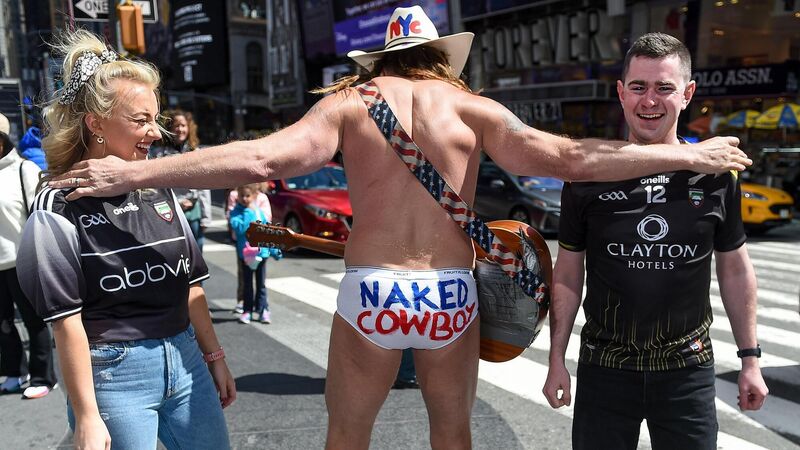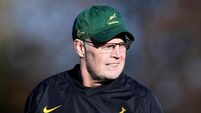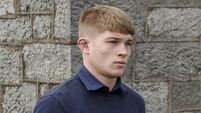Michael Moynihan: Some words to the wise

Sligo supporters Rory Dillon, left, from Ballysadare, Sligo, and Niamh Marshall, right, from Sligo town, in Times Square ahead of the Connacht SFC quarter-final at Gaelic Park in New York
I enjoyed another episode of The Press Box podcast the other day, one in which NFL broadcaster Peter Schrager mused on next season’s prospects.
And the terminology associated with those prospects.
The NFL generated $1.8 billion in revenue last year and takes player assessment very seriously, which is why I instantly fell in love with some of the terms used — like oily hips, in relation to a player’s ability to change direction suddenly.
(Oily is therefore desirable; stiff hips, by contrast, are not.)
Schrager also cited the term pad level, a measurement of an attacking player’s ability to run low to the ground - so that his shoulder pads are lower than his covering defender’s - in order to gain leverage.
Ah, I hear you say: What about something we can all relate to now that the intercounty championship has begun in earnest?
Well, how about catch radius, another term used about NFL prospects? That could surely be applied to promising hurlers and footballers alike, a metric handy for describing their ability to haul in the ball hurtling towards or above them, like TJ Reid and Michael Murphy in their respective fields.
Mind you, in the interests of clarity I should include a working definition of catch radius as applied in American football, as according to one online resource it “incorporates a player’s ability to cover ground as well as his ability to get vertical in order to score a player’s capacity to reaching the football in a 3-dimensional space. Catch Radius affects a player’s ability to succeed in the red zone, particularly on fade routes and 50-50 balls. The equation squares a player’s 40-time, 20-yard shuttle, and 3-cone and multiplies it by the square of a player’s height, arm length, and vertical jump. The values of all six data inputs are normalized to have equal weight.”
Maybe “good hands” would do just as well.
Still, I had to start digging even deeper into this world of draft terminology. I was encouraged to see the term T-Rex arms used to describe players who won’t reach up for a ball in case of injury, something many (hurling and football) defenders accuse (hurling and football) attackers of when delivery is not inch-perfect.
(Apparently it’s a term that can also be repurposed for those who are slow to reach for their wallets when the bill comes.) Saying that players have a go-home gear which separates them from their peers is self-explanatory. What wasn’t so clear was the dismissal of so many prospects as JAGs, until I realised that was an acronym standing in for Just Another Guy: as in, the guy with a go-home gear made all the defenders look like JAGs. (May not be verbatim transcript)
Baby steps, of course. I don’t expect any accounts of Cork-Limerick or Waterford-Tipperary to have descriptions of washcloth tackling this morning (i.e. a defender who puts in a tackle which sticks for a split second and then slides downwards: like a washcloth hitting a wall).
Culture change takes time, and engrained modes of thought can be difficult to eradicate.
People can deploy plenty of terminology without having an exact handle on its meaning, too.
Take Peter Schrager, with whom we started.
“No-one knows what pad level is,” he said on that podcast.
“I was a sideline reporter for three years and I don’t know what pad level means.”
The sensory overload comes on fast with the intercounty championship, even if it’s a little earlier than usual.
The splash of colour, the summer sun (not in the weekend just gone, maybe, but still), and one of the hardiest survivors in the catechism of cliches: the roar of the crowd.
Because of Covid these past couple of years that roar isn’t something we take for granted any more, and it was great to hear spectators in full voice at venues over the weekend.
(Work out for yourself the effect on newish players of operating in the full-on, call-obliterating white noise of a full venue compared to the eerie, lunar silences of two years ago.) The return of the roar reminded me of the experience of a former work colleague a few years ago in Dublin. He was living a couple of miles from Croke Park and the All-Ireland final was on, and a dramatic goal was scored late on.
My pal was watching on his couch at home but muted the TV and moved to the window: sure enough, a few seconds later a rolling noise came drifting up from the stadium. Years later he said it remained his strongest memory from the game.
It would be an intriguing challenge to construct the narrative of a game in any code by virtue of the crowd noise alone, but there’s always been a haunting quality sport’s second-hand noise.
The name Mike Bossy may not mean much to readers, but he was an ice-hockey star who featured for the New York Islanders in the seventies.
He passed away recently and one of the obituaries mentioned a neighbour who knew when Bossy was practicing in his family’s back yard as a child: he couldn’t see what was going on but he could hear the whizz of the puck as it was flaked around by the youngster.
It was reminiscent of a piece I read long ago about the great basketball star Larry Bird in which a reporter watched him practice his shooting and noted the rhythm in sounds: the swish of the ball through the net, the thud of the ball landing, and the squeak of basketball boots on timber as Bird collected the ball and began the sequence all over again.
You can apply the same to hurling, with the sound of hurley on ball, ball to wall, ball back to hurley, or the subdued smack of a football hitting a corner of the net, or whatever sport you choose. Second-hand sound tells you everything.
Oh dear. I see that Cork is not the only county with a fixture issue.
Sligo have told the Connacht Council they won’t play next Wednesday’s U20 final if it’s fixed for Bekan rather than at home (for Sligo) in Markievicz Park.
It’s interesting that Sligo have added that if the game is being played in Bekan to facilitate TG4 then the broadcaster should rearrange its schedule.
There’s still enough time to resolve this one, but if it is then it’ll soon be compared to what’s going on a few hours’ drive to the south. Will any resolution be taken as the template for the impasse in Munster, or is a truly left-field answer going to be necessary for Cork v Kerry to go ahead?
Hardly news to say that a Ben MacIntyre book is a guarantee of quality, but a couple of weeks ago I got a present of The Spy and The Traitor, MacIntyre’s account of Oleg Gordievsky’s career as a double agent.
Published four years ago, it’s terrific if you’re a tradecraft nerd - guilty as charged. Recommended.
Just make sure you’re not tailed when you’re buying it.
Contact: michael.moynihan@examiner.ie









